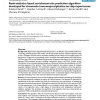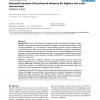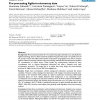47 search results - page 6 / 10 » Methods for Designing Reliable Probe Arrays |
BMCBI
2008
13 years 7 months ago
2008
Background: A primary reason for using two-color microarrays is that the use of two samples labeled with different dyes on the same slide, that bind to probes on the same spot, is...
BMCBI
2006
13 years 7 months ago
2006
Background: High density oligonucleotide tiling arrays are an effective and powerful platform for conducting unbiased genome-wide studies. The ab initio probe selection method emp...
BMCBI
2007
13 years 7 months ago
2007
Background: As part of its broad and ambitious mission, the MicroArray Quality Control (MAQC) project reported the results of experiments using External RNA Controls (ERCs) on fiv...
CISS
2008
IEEE
14 years 2 months ago
2008
IEEE
—Reliable wireless communications often requires accurate knowledge of the underlying multipath channel. This typically involves probing of the channel with a known training wave...
BMCBI
2007
13 years 7 months ago
2007
Background: Pre-processing methods for two-sample long oligonucleotide arrays, specifically the Agilent technology, have not been extensively studied. The goal of this study is to...



